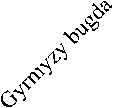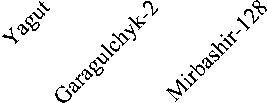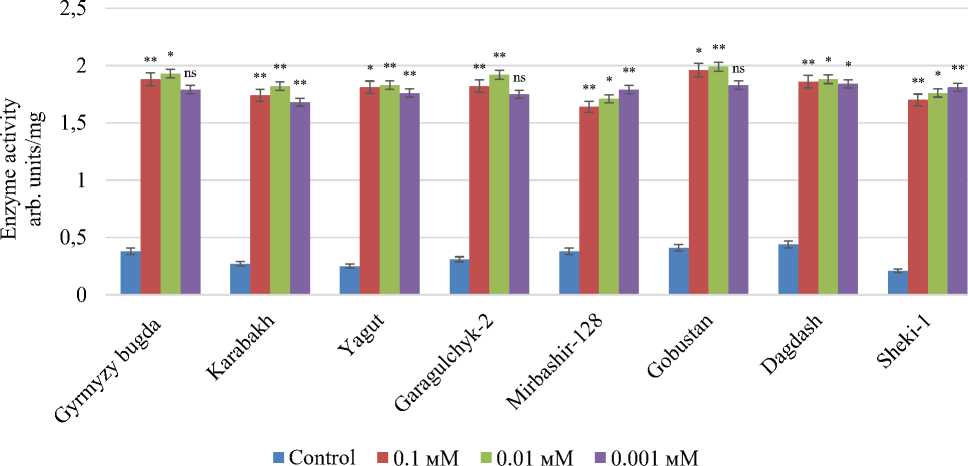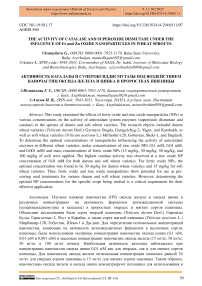The activity of catalase and superoxide dismutase under the influence of Fe and Zn oxide nanoparticles in wheat sprouts
Автор: Ismayilova G., Azizov I.
Журнал: Бюллетень науки и практики @bulletennauki
Рубрика: Естественные науки
Статья в выпуске: 2 т.11, 2025 года.
Бесплатный доступ
This study examined the effects of ferric oxide and zinc oxide nanoparticles (NPs) at various concentrations on the activity of antioxidant system enzymes (superoxide dismutase and catalase) in the sprouts of durum and soft wheat varieties. The research objects included durum wheat varieties ( Triticum durum Desf.) Gyrmyzy Bugda, Garagylchyg-2, Yagut, and Karabakh, as well as soft wheat varieties ( Triticum aestivum L.) Mirbashir-128, Gobustan, Sheki-1, and Dagdash. To determine the optimal concentrations of nanoparticles influencing the activity of antioxidant enzymes in different wheat varieties, molar concentrations of zinc oxide NPs (0,1 mM, 0,01 mM, and 0,001 mM) and mass concentrations of ferric oxide NPs (15 mg/kg, 30 mg/kg, 50 mg/kg, and 100 mg/kg of soil) were applied. The highest catalase activity was observed at a zinc oxide NP concentration of 0,01 mM for both durum and soft wheat varieties. For ferric oxide NPs, the optimal concentration was found to be 30 mg/kg for durum wheat varieties and 15 mg/kg for soft wheat varieties. Thus, ferric oxide and zinc oxide nanoparticles show potential for use as pre-sowing seed treatments for various durum and soft wheat varieties. However, determining the optimal NP concentrations for the specific crops being studied is a critical requirement for their effective application.
Nanoparticles, enzymes, durum and soft wheat, catalase, superoxide dismutase
Короткий адрес: https://sciup.org/14131840
IDR: 14131840 | УДК: 581.19:581.17 | DOI: 10.33619/2414-2948/111/07
Текст научной статьи The activity of catalase and superoxide dismutase under the influence of Fe and Zn oxide nanoparticles in wheat sprouts
Бюллетень науки и практики / Bulletin of Science and Practice
Currently, nanoscience and nanotechnology have made significant progress, enabling the synthesis and production of engineered nanoparticles (NPs) of various types, sizes, and morphologies. Recently, many studies have focused on investigating the physiological responses of plants to the effects of nanoparticles during germination. The results of studies on the impact of nanoparticles (NPs) on plants have been contradictory and are primarily based on examining their short-term effects or the effects of their high concentrations [4, p. 2].
These findings suggest that further studies focused on high-throughput analysis of genetic and metabolic responses induced by nanoparticle (NP) exposure are necessary to shed light on many aspects of NP phytotoxicity in agricultural crops, even in the absence of apparent phenotypic changes [1, p.209]. In light of this evidence, it would be reasonable to apply nanoparticles (NPs) to plants that already have an established safety profile for use in living systems, such as soft, polymeric NPs. It has been found that copper oxide NPs inhibit the activity of soil enzymes and reduce plant biomass accumulation [5, p. 33].
Today, nanoparticles (NPs) are highly popular and widely used across various industries. Research results show that metal NPs and their oxides are harmful to plants in excessive amounts, while trace quantities can have a positive effect. Consequently, the increasing concentration of NPs in the environment could pose a significant threat to agriculture in the future. Although the literature provides clear information on the effects of metal NPs and their oxides on plants, further studies are needed to uncover the molecular mechanisms of their action [6, p. 2].
Plants often or continuously encounter unfavorable environmental conditions during their life cycle, leading to the excessive production of reactive oxygen species (ROS). These highly reactive molecules can cause oxidative damage to proteins, lipids, and nucleic acids, disrupting cellular functions. To mitigate such damage, the regulation of ROS levels in plant cells is carried out by the antioxidant defense system (ADS) [2, p. 369].
The antioxidant defense system is a sophisticated, multi-component, and multi-level mechanism within plant cells. It comprises high-molecular-weight enzymes, such as catalase, superoxide dismutase, and peroxidase, along with low-molecular-weight antioxidants like ascorbic acid, glutathione, and flavonoids. This system operates in a highly coordinated manner, ensuring effective detoxification of ROS and protection of cellular components. The balance and stability of ADS components are critical for the survival, growth, and adaptation of plants to stress factors, enabling them to maintain vital physiological processes under challenging environmental conditions [9, p. 165].
Materials and methods
The research objects were varieties of durum wheat ( Triticum durum Desf.) — Gyrmyzy Bugda, Garagylchyg-2, Yagut, and Karabakh — and soft wheat ( Triticum aestivum L.) — Mirbashir-128, Gobustan, Sheki-1, and Dagdash, purchased from the Agricultural Research Institute (RI) of Azerbaijan. The seeds of all these wheat genotypes were first disinfected with 0.01%
Бюллетень науки и практики / Bulletin of Science and Practice Т. 11. №2 2025
KMnO4 solution for 5 min, and after washing three times with distilled water, the control and experimental seeds were germinated in pots with soil within 14 days, under 12-h light. The samples were exposed to a temperature of 24±1°С and humidity at 80±5%, avoiding drying of seedlings in a climatic chamber (Taisite GZX-300E, China). To identify the optimal concentrations of nanoparticles (NPs) affecting the activity of antioxidant system (AOS) enzymes of various durum and soft wheat varieties, we prepared NP solutions at varying concentrations. These solutions were created using ultrasonification methods and included ferric oxide (15 mg/kg; 30 mg/kg; 50 mg/kg; 100 mg/kg), zinc oxide (0,1 mM; 0,01 mM; 0,001 mM).
The permanganatometric method developed by A. N. Bach and A. I. Oparin was used to determine the activity of the enzyme catalase (CAT, EC 1.11.1.6). The activity of the enzyme superoxide dismutase (SOD, EC 1.15.1.1) was determined using the method of inhibiting the photoreduction of nitroblue tetrazolium (NBT). SOD activity was measured by the decrease in optical density on a spectrophotometer (MRC, model UV-200-RS, Israel) at a wavelength of 560 nm after 30 minutes of incubation for the tested samples. Protein content in the enzymatic preparation was quantified using the Bradford method [3, pp. 1-29]. Enzyme activity was expressed in arbitrary units per milligram of protein over 30 minutes (arb. units/mg protein).
All experiments were conducted in triplicate biological replicates, with each experiment independently reproduced three times. Statistical analysis of the data was performed using Microsoft Excel. Interpretation of the statistical parameters was carried out with the official software platform Social Science Statistics. The reliability of differences between the averaged values was assessed using Student's t-test.
Results and discussion
Catalase (CAT, EC 1.11.1.6) is an essential enzyme in the plant antioxidant defense system. This heme-containing enzyme, weighing around 250 kDa, facilitates the conversion of hydrogen peroxide (H₂O₂) into water and molecular oxygen. It is primarily located in peroxisomes and glyoxysomes, with a specific variant also found in mitochondria [8, p. 31]. Unlike peroxidases, catalase is highly efficient at breaking down elevated concentrations of H₂O₂. Research indicates that the activity of CAT in wheat sprouts treated with ferric oxide nanoparticles (NPs) is influenced by the specific characteristics of the wheat varieties.
0,35
**
**
** ** ** ****
I 0,3 ** ****
Г 00,,012,525 **** ** ****** **** **** **** **** ******
0,00,51 ** **** ** ** ** ****
**






■ Control
■ 15 mg/kg ■ 30 mg/kg ■ 50 mg/kg ■ 100 mg/kg
-
Figure 1. The effect of different concentrations of iron (III) oxide NPs on CAT activity in wheat varieties. Statistical analysis was performed using the Student's t-test: differences in mean values are considered significant at p < 0.01 (**) and p < 0.05 (*)
According to the data presented in Figure 1, the highest enzyme activity was observed in the sprouts of the soft wheat variety Mirbashir-128 under the influence of nanoparticles (NPs) at a concentration of 15 mg/kg, which was approximately 2.5 times higher than the control values for this variety. The lowest enzyme activity was recorded in the sprouts of the hard wheat variety Karabakh exposed to ferric oxide NPs at a concentration of 100 mg/kg.
Thus, relatively low concentrations of ferric oxide NPs had a stimulating effect on CAT activity, whereas at a concentration of 100 mg/kg of soil, the enzyme activity significantly decreased in both hard and soft wheat varieties. Based on the research findings, the most optimal concentration of ferric oxide NPs was determined to be 15 mg/kg.
Superoxide dismutase (SOD, EC 1.15.1.1) catalyzes the dismutation of two superoxide radicals, resulting in the formation of H₂O₂ and molecular oxygen. This enzyme plays a critical role in protecting plant cells and tissues from oxidative damage and the adverse effects of environmental stressors. However, H₂O₂, produced during the dismutation of the superoxide anion radical, can act as an inhibitor of SOD activity. Therefore, the efficient performance of SOD depends on the proper functioning of other components of the antioxidant defense system (ADS) [7, p. 924].
Experiments investigating the impact of different concentrations of ferric oxide nanoparticles (NPs) on SOD activity in the sprouts of soft and durum wheat varieties yielded the results shown in Figure 2.
ьр
о fl n' "8
Й a
W
0,45
0,4
0,35
0,3
0,25
0,2
0,15
0,1
0,05
**
**
**
**
**
** ****
****** ****** **** *** ** ****
** ** * ** ** **** *** **ns******
№
C^
6°
■ Control ■ 15 mg/kg ■ 30 mg/kg ■ 50 mg/kg ■ 100mg/kg
-
Figure 2. The effect of different concentrations of iron (III) oxide NPs on SOD activity in wheat varieties. Statistical analysis was performed using the Student's t-test: differences in mean values are considered significant at p < 0.01 (**) and p < 0.05 (*)
Based on the results of the conducted experiments, ferric oxide nanoparticles (NPs) at concentrations of 15 mg/kg, 30 mg/kg, and 50 mg/kg promoted an increase in SOD activity in all studied varieties of Triticum durum Desf. and Triticum aestivum L. . However, at a concentration of 100 mg/kg, a significant decrease in SOD activity was observed in wheat sprouts. The highest enzyme activity was recorded in the sprouts of the hard wheat variety Karabakh at an NP concentration of 15 mg/kg, which was approximately 83% higher than the control. In contrast, the lowest SOD activity was noted in the sprouts of the soft wheat variety Sheki-1 under the influence of NPs at a concentration of 100 mg/kg of soil.
The data presented in fig. 2 indicate that at relatively low concentrations, ferric oxide NPs had a stimulating effect on SOD activity, which holds significant practical importance.
In the course of the research, the effect of three concentrations of zinc oxide nanoparticles (0.1 mM, 0.01 mM, and 0.001 mM) on enzyme activity was studied (Figure 3).
2,5
**
**
*
*
ns
**
**
**
**
ns
1,5
N
Й
W
-5° Ы
ns ns
****ns********* *ns **********ns
0,5
6°
<^
-
■ Control
-
■ 0.1 мМ
-
■ 0.01 мМ
-
■ 0.001 мМ
-
Figure 3. The effect of different concentrations of zinc oxide NPs on CAT activity in wheat varieties. Statistical analysis was performed using the Student's t-test: differences in mean values are considered significant at p < 0.01 (**) and p < 0.05 (*)
The highest catalase (CAT) activity was recorded at a concentration of 0,01 mM of metal oxide nanoparticles. Among Triticum durum Desf. varieties, the sprouts of Gyrmyzy Bugda exhibited an activity level six times higher than the control values for this variety. For Triticum aestivum L. varieties, the Gobustan sprouts showed the highest activity, with a 400% increase compared to the control. The lowest enzyme activity was observed at a zinc oxide NP concentration of 0,001 mM, specifically in the hard wheat variety Garagylchyg-2 and the soft wheat variety Dagdash. An in-depth examination of the data in Figure 3. highlights that the impact of zinc oxide nanoparticles on CAT activity varies depending on the varietal characteristics of the crops. While increasing NP concentrations led to a rise in enzyme activity relative to the control in all studied hard and soft wheat varieties, the optimal concentration was found to be 0,01 mM.
The data presented in fig. 4 demonstrate the stimulating effect of metal oxide nanoparticles (NPs) on enzyme activity across all studied wheat varieties. The nature of the NP effect varied between hard and soft wheat varieties. In hard wheat varieties, the activity of SOD increased with rising concentrations of zinc oxide NPs. However, in soft wheat varieties, this trend was not consistent, except for the varieties Mirbashir-128 and Sheki-1. For the soft wheat varieties Gobustan and Dagdash, the optimal concentration of zinc oxide NPs was determined to be 0,01 mM.
As illustrated on Figure 4, the highest SOD activity among Triticum durum Desf. varieties was observed in the sprouts of Gyrmyzy Bugda treated with metal oxide nanoparticles (NPs) at a concentration of 0,01 mM, which was five times greater than the control values for this variety. For soft wheat varieties, the maximum enzyme activity was detected in the sprouts of Gobustan at the same NP concentration. Conversely, the lowest SOD activity under the influence of zinc oxide NPs was recorded in the sprouts of the hard wheat variety Karabakh at a concentration of 0,001 mM and in the soft wheat variety Mirbashir-128 at a concentration of 0,1 mM. These findings highlight a dependence of SOD activity on the varietal characteristics of wheat when exposed to these nanoparticles.

Figure 4. The effect of different concentrations of zinc oxide NPs on SOD activity in wheat varieties. Statistical analysis was performed using the Student's t-test: differences in mean values are considered significant at p < 0.01 (**) and p < 0.05 (*)
Conclusions
Thus, it was established, that the effect of iron (III) oxide and zinc oxide nanoparticles on the activity of antioxidant enzymes depended on both the applied concentrations of the nanoparticles and the varietal characteristics of the studied crops. Different wheat varieties demonstrated varying resistance to the effects of nanoparticles, which is associated with their genetic characteristics and adaptive responses to changes in plant metabolism.
For the seedlings of the studied durum wheat varieties, the optimal concentration of iron (III) oxide nanoparticles was 30 mg/kg, while for Triticum aestivum L. samples, this dose ranged from 15 to 30 mg/kg. The Dagdash variety proved to be resistant to the effects of increased doses of iron (III) oxide nanoparticles, which is important for the development of less vulnerable wheat varieties that play a key role in plant breeding.
Список литературы The activity of catalase and superoxide dismutase under the influence of Fe and Zn oxide nanoparticles in wheat sprouts
- Majumdar S., Peralta-Videa J. R., Trujillo-Reyes J., Sun Y., Barrios A. C., Niu G., Gardea-Torresdey J. L. Soil organic matter influences cerium translocation and physiological processes in kidney bean plants exposed to cerium oxide nanoparticles // Science of the Total Environment. 2016. V. 569. P. 201-211. https://doi.org/10.1016/j.scitotenv.2016.06.087.
- Mammadli G. H. The activity of ascorbate peroxidase in seedlings of durum and soft wheat varieties under the influence of trivalent ferric oxides nanoparticles // International Journal of Scientific & Engineering Research, 2020. V. 11. №8. P. 369-374.
- Olson B. J. S. C., Markwell J. Assays for determination of protein concentration // Current Protocols in Pharmacology. 2007. V. 38. №1. P. A. 3A. 1-A. 3A. 29. https://doi.org/10.1002/0471141755.pha03as38.
- Pérez-de-Luque A.Interaction of nanomaterials with plants: what do we need for real applications in agriculture? // Frontiers in Environmental Science. 2017. V. 5. P. 12. https://doi.org/10.3389/fenvs.2017.00012.
- Qafoku N. P. Terrestrial nanoparticles and their controls on soil-/geo-processes and reactions // Advances in agronomy. 2010. V. 107. P. 33-91. https://doi.org/10.1016/S0065-2113(10)07002-1.
- Rizwan M., Ali S., Qayyum M. F., Ok Y. S., Adrees M., Ibrahim M., Abbas F. Effect of metal and metal oxide nanoparticles on growth and physiology of globally important food crops: A critical review // Journal of hazardous materials. 2017. V. 322. P. 2-16. https://doi.org/10.1016/j.jhazmat.2016.05.061.
- Беловолова Л. В. Активные формы кислорода в водных средах (обзор) // Оптика и спектроскопия. 2020. Т. 128. №7. С. 923-942. https://doi.org/10.21883/OS.2020.07.49565.64-20.
- Дыкман Л. А., Щёголев С. Ю. Взаимодействие растений с наночастицами благородных металлов // Сельскохозяйственная биология. 2017. Т. 52. №1. С. 13-24. https://doi.org/10.15389/agrobiology.2017.1.13rus.
- Креславский В. Д., Лось Д. А., Аллахвердиев С. И., Кузнецов В. В. Сигнальная роль активных форм кислорода при стрессе у растений // Физиология растений. 2012. Т. 59. №2. С. 163-163.


